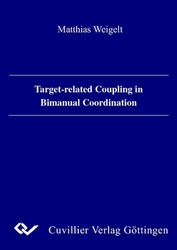| Areas | |
|---|---|
| Serie de libros (96) |
1378
|
| Nachhaltigkeit |
3
|
| Gesundheitswesen |
1
|
| Letra |
2364
|
| Medienwissenschaften | 16 |
| Teología | 57 |
| Filosofía | 102 |
| Derecho | 422 |
| Economía | 850 |
| Ciencias sociales | 416 |
| Ciencias del deporte | 48 |
| Psicología | 233 |
| Educación | 190 |
| Historia | 182 |
| Arte | 111 |
| Ciencias culturales | 166 |
| Literatur | 116 |
| Lingüística | 88 |
| Ciencias Naturales |
5406
|
| Ciencias Ingeniería |
1793
|
| General |
98
|
|
Leitlinien Unfallchirurgie
5. Auflage bestellen |
|
Erweiterte Suche
Target-related Coupling in Bimanual Coordination (Tienda española)
Matthias Weigelt (Autor)Previo
Indice, Datei (6,1 KB)
Lectura de prueba, Datei (53 KB)
It is concluded that the control of bimanual actions can be explained by target coordination. Experimental evidence has been provided to support the notion that the bimanual coupling effects observed during the simultaneous coordination of the two hands relate to movement targets, but not to the movements themselves. These bimanual coupling effects are transient, as the initial preparation advantage for bimanual movements to the same targets vanishes with longer time to prepare the actions. The transient target-coupling hypothesis states that bimanual movements directed at different targets can be prepared equally well as bimanual movements directed at the same targets when there is sufficient time for movement preparation to take place. It is further suggested that participants established a mental representation of the action environment (task set), where the actions targets were represented in terms of their spatial correspondence relative to the active effectors (relative spatial-position hypothesis). The present findings are in line with theories emphasizing the roles of movement-extrinsic targets and intended action goals on action control. Thus, the coordination of the two hands must be seen in service of these external targets and action goals.
| ISBN-10 (Impresion) | 3865374808 |
| ISBN-13 (Impresion) | 9783865374806 |
| ISBN-13 (E-Book) | 9783736914803 |
| Idioma | Alemán |
| Numero de paginas | 172 |
| Edicion | 1 Aufl. |
| Lugar de publicacion | Göttingen |
| Lugar de la disertacion | München |
| Fecha de publicacion | 04.07.2005 |
| Clasificacion simple | Tesis doctoral |
| Area |
Psicología
|








